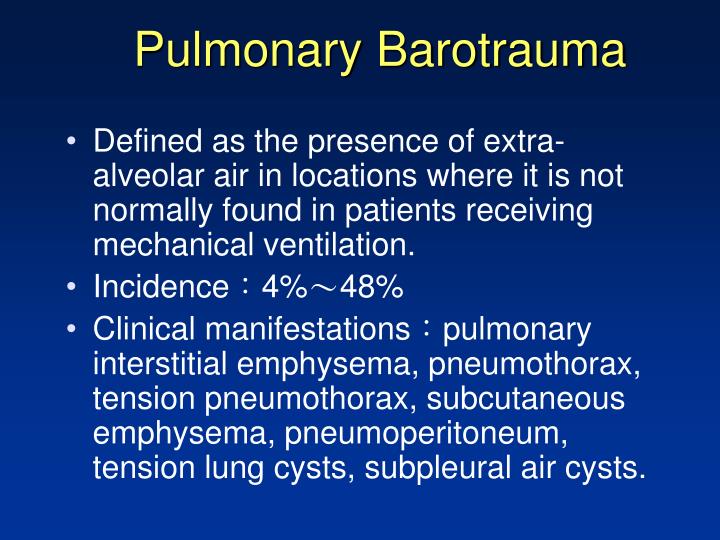

The effects on the vessels results in a disturbance of vascular permeability and microvascular flow which can cause a breakdown in the blood brain barrier 4 Direct damage to the tissue resulting from the gas bubbles is thought to be caused by artery occlusion, damage to vascular endothelium and venous outflow obstruction.

It is thought there are two main effects from evolved gas:
#Treatment for pulmonary barotrauma full
The full mechanism and pathophysiology of DCS is poorly understood and still being researched. This can happen anywhere in the body but is commonly seen in the articular cartilage (joints) and nervous tissue especially the spinal cord. The inert gas that evolves from the tissues can then cause a mass effect and inflammatory response in that tissue. It is sometimes described as being caused by evolved gas. Pathophysiology of Decompression Illnessĭecompression illness (DCI) is the umbrella term used to encompass both decompression sickness (DCS) and arterial gas embolism (AGE).ĭecompression sickness is caused by nitrogen coming out of solution when a diver ascends from a dive. Boyle’s law helps to explain arterial gas embolism and Henry’s law helps to explain decompression sickness. Enriched air nitrox (a higher content of oxygen than air, mixed with nitrogen)īoyle’s law and Henry’s law are fundamental in understanding dive medicine.However, many divers also use other gas mixes such as: Therefore, varying their exposure to inert gases such as nitrogen. at pressure, the partial pressure of nitrogen increases:ĭifferent divers breathe different gas mixtures depending on the type of diving they are doing. These bubbles can lead to decompression sickness (a type of decompression illness).Īt depth, i.e. The nitrogen coming out of solution can form bubbles, particularly if divers ascend too fast, or miss any stops on their ascent. As the diver ascends, nitrogen comes out of solution. As the diver descends, more nitrogen dissolves in to the blood. More nitrogen dissolves at greater partial pressures. This means it is not metabolised by the body and so the content does not change in inhaled and exhaled gas. Why are gases relevant in diving medicine? HENRY’S LAW: At a constant temperature, the amount of gas that will dissolve in a liquid is proportional to the partial pressure of the gas over that liquid.

Can cause arterial gas embolism (a type of decompression illness).Usually due to a very rapid ascent or divers holding their breath.The most dangerous is pulmonary barotrauma. Divers can get pain in their ears and sinuses on ascent and descent.Affects air spaces in the body- ears, sinuses, lungs.Why are pressure changes relevant in diving medicine?īAROTRAUMA = trauma caused by pressure changes The most important of these in diving and DCI are Boyle’s law and Henry’s law.īOYLE’S LAW: At a constant temperature, the absolute volume of a fixed mass of gas is inversely proportional to the absolute pressure. Gas laws underpin most of basic diving physics and physiology: With every 10m of seawater, this pressure increases by 1 ATA. Pressure can be measured in many different units- here we will focus on atmospheres absolute (ATA). The most important concept to understand in diving medicine is pressure. It includes both decompression sickness and arterial gas embolism. These will be explained in more detail further in the module.ĭecompression illness is a disease caused by a reduction in pressure, where gas bubbles form in the tissues or circulation causing damage. There are two types of decompression illness: decompression sickness (DCS) and arterial gas embolism (AGE). 2 In the United Kingdom (UK) this is most commonly seen in divers. 1ĭecompression Illness (The Bends) is a disease of compressed gas divers, aviators, astronauts and caisson workers where gas bubbles form in tissues and/or the blood during or after a decrease in environmental pressure. There were 19 fatal incidents in 2017, which was the highest number since 2004. This was incongruent with the previous four years where DCI was the most common. In 2018, injury was the most common incident followed by Decompression Illness (DCI). There were up to 30-50 incidents per month between May – September. The British Sub Aqua Club (BSAC) reported 215 diving incidents in 2018. Diving-related problems can present in many ways and their appropriate and timely management is essential for good outcomes and patient safety. Diving-related problems are rarely covered during medical school and specialty training and the basic science underpinning diving is often not well understood.


 0 kommentar(er)
0 kommentar(er)
